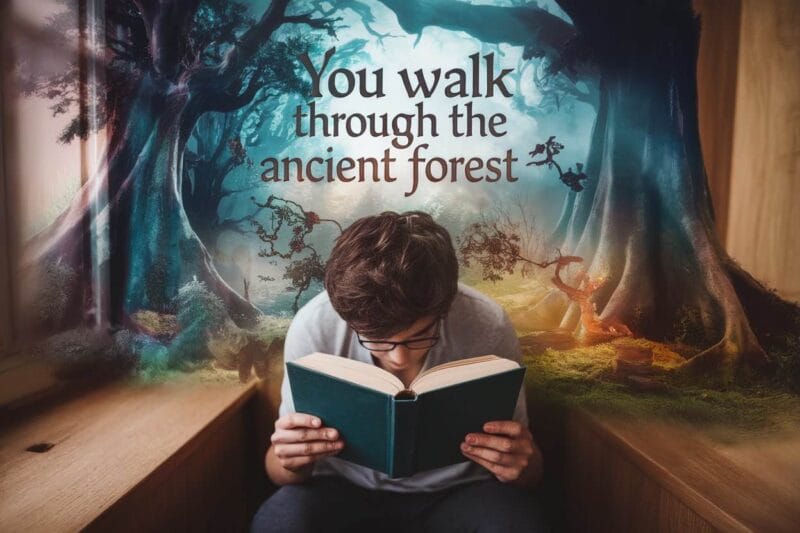Some of the most enduring works of fiction employ a perspective that grants the storyteller boundless knowledge—the ability to move freely across time, space, and the minds of characters. This technique, known as the “third-person omniscient point of view,” has shaped narratives from classics to modern fiction.
Unlike first-person narration—which restricts the story to a single character’s awareness—or third-person limited—which adheres closely to one perspective—omniscient narration offers an expansive vantage point. Writers like Leo Tolstoy and George Eliot wielded it to construct sweeping historical and social portraits, while contemporary authors adapt it for layered storytelling.
This article examines how third-person omniscient functions, its advantages over limited perspectives, and the techniques that make it effective. By analyzing key examples and addressing common challenges, we can understand why this narrative mode remains indispensable in writing.
What does omniscient mean?
The term omniscient originates from Latin—omnis (all) and scientia (knowledge)—literally meaning “all-knowing.” In literature, an omniscient narrator possesses unlimited awareness, accessing the thoughts, emotions, and backstories of every character. This contrasts sharply with limited perspectives, where the narrator reveals only what a single character perceives.
Omniscience enables a storyteller to shift seamlessly between locations and time periods. For instance, in Anna Karenina (1878), Tolstoy transitions from Levin’s rural struggles to Anna’s societal downfall, which creates a panoramic view of 19th-century Russia. The narrator’s detachment allows for irony, as when characters misunderstand each other while the audience grasps the full truth.
However, this freedom demands control. Without careful management, omniscience can overwhelm the reader or dilute tension. The best omniscient narrators balance godlike knowledge with deliberate pacing, ensuring clarity without sacrificing immersion.
Third-Person Omniscient vs. Limited
While the previous section outlined the broad distinctions between omniscient and limited narration, this section will examine their differences in greater depth—analyzing how each point of view shapes narrative scope, character intimacy, and thematic possibilities.
Third-Person Omniscient
- Scope: Panoramic Insight into Multiple Consciousnesses — The omniscient perspective grants unrestricted access to the thoughts, memories, and hidden motivations of every character within a story. This godlike vantage point enables writers to contrast internal experiences—for example, revealing how two characters privately misinterpret each other’s actions while maintaining polite facades. Again, Tolstoy employs this technique masterfully in Anna Karenina by juxtaposing Levin’s spiritual turmoil with Anna’s destructive passions, thereby highlighting the novel’s central tensions between rural stability and urban decadence.
- Flexibility: Seamless Temporal and Spatial Movement — An omniscient narrator can shift between locations, time periods, and levels of abstraction without jarring transitions. In One Hundred Years of Solitude (1967), Gabriel García Márquez blends generations of the Buendía family with historical events and magical elements, which create a tapestry wherein individual lives intersect with collective memory. This fluidity is particularly effective for epics or multi-generational sagas where rigid adherence to a single perspective would fragment the narrative.
- Effect: Layered Irony and Thematic Resonance — By exposing disparities between characters’ perceptions and objective reality, omniscience generates dramatic irony. Eliot’s Middlemarch (1871) derives much of its power from the narrator’s ability to contrast Dr. Lydgate’s professional idealism with Rosamond Vincy’s shallow materialism while subtly revealing how both misread each other’s motives. The technique also amplifies thematic depth; in Anthony Trollope’s The Way We Live Now (1875), the narrator uses omniscience to trace how individual greed (Melmotte’s financial fraud) and naivete (Paul Montague’s trust) collide with Victorian society’s moral decay, weaving minor characters’ compromises into a sweeping indictment of corruption.
Third-Person Limited
- Focus: Laser-Sharp Character Alignment: Limited narration adheres strictly to one character’s viewpoint per scene or chapter, filtering all events through their subjective awareness. This constraint mirrors human experience—readers, like the focal character, must interpret others’ motives based on external behavior. In Part 1 of Ian McEwan’s Atonement (2001), the third-person limited perspective remains rigorously bound to 13-year-old Briony Tallis’s flawed perception. Only later does the novel reveal how her limited viewpoint catalyzes the irreversible tragedy.
- Immersion: Psychological Intimacy and Sustained Suspense: By denying access to other characters’ minds, limited POV provokes empathy for the protagonist while preserving mystery. J.K. Rowling’s Harry Potter series leverages this to great effect: Harry’s ignorance of Snape’s true loyalties or Dumbledore’s plans mirrors the reader’s own curiosity, making revelations more impactful. The approach excels in thrillers and coming-of-age stories where emotional proximity to the protagonist is paramount.
- Strategic Restriction for Narrative Payoff: Unlike omniscience, which risks diffusing tension through overexposure, limited narration can strategically withhold information. Patricia Highsmith’s The Talented Mr. Ripley (1955) gains its unsettling power by locking readers into Tom Ripley’s warped perspective. The third-person limited narration reveals just enough of Ripley’s calculated charm and escalating paranoia to make his crimes feel disturbingly intimate while obscuring his full monstrosity until key moments.
Writers select omniscience for stories requiring broad societal commentary or intricate subplots. Limited perspectives suit character-driven tales where suspense hinges on restricted knowledge. A hybrid approach, like shifting omniscience between key characters, can offer both breadth and intimacy.
Illustrative Examples of Third-Person Omniscient Narration
These works demonstrate the narrative power of omniscience—its ability to reveal systemic forces through interconnected lives, to juxtapose individual psychologies against collective histories, and to position the narrator as both witness and philosopher. The technique thrives when stories demand simultaneity (multiple consciousnesses unfolding in parallel) or when the act of narration itself carries thematic weight.
Classic Literature
- Leo Tolstoy’s War and Peace (1867): This is a classic example. The narrator moves seamlessly between the perspectives, thoughts, and feelings of a vast array of characters (Pierre, Andrei, Natasha, Nikolai, Marya, Napoleon, Kutuzov, etc.), providing deep insights into their inner lives and motivations, as well as historical context and philosophical commentary.
- George Eliot’s Middlemarch (1871): A masterclass in omniscient narration, with psychological insight into a wide cast and philosophical interjections from a narrator who sees beyond any single character’s perception. The narrator has godlike knowledge of every character’s thoughts, histories, and motivations.
- Anthony Trollope’s The Way We Live Now (1875): Trollope’s narrator has full access to multiple characters’ thoughts, motivations, and secrets. The narrator also occasionally comments directly on characters and society, emphasizing omniscient authority.
Modern Fiction
- Don DeLillo’s White Noise (1985): Though centered on Jack Gladney, the narration periodically detaches to observe other characters’ inner lives (e.g., his wife Babette’s secret anxieties) and broader cultural absurdities, fulfilling an omniscient function. While it’s often mistaken for limited, DeLillo’s control of perspective moves beyond that boundary.
- Zadie Smith’s White Teeth (2000): This novel features a distinct and often opinionated third-person omniscient narrator who hops between the perspectives, histories, and thoughts of a wide cast of characters spanning multiple generations and families (e.g., Archie, Samad, Clara, Alsana, Irie, Millat, Magid).
- Richard Powers’ The Overstory (2018): Employs a far-reaching omniscient perspective to connect the lives of nine distinct characters deeply affected by trees. The narrator reveals not only the characters’ varied inner worlds but also possesses profound, almost non-human insights into the forest ecosystem, weaving human drama into a vast ecological tapestry.
Mastering Omniscient Narration: Techniques and Pitfalls
Omniscient narrators fluidly adjust their proximity to characters, alternating between panoramic scope and intimate close-ups. A wide lens might describe a city’s history or the sprawl of a battlefield, while a tight focus could linger on a character’s moment of regret. In Charles Dickens’s Bleak House (1853), the narrator oscillates between two distinct modes: the detached, satirical voice that maps London’s fog-choked legal system and the vulnerable first-person perspective of Esther Summerson, whose personal account grounds the story in raw, emotional immediacy.
Common Pitfalls
- Head-hopping: Abrupt shifts between characters’ inner thoughts—without clear scene breaks, temporal markers, or tonal transitions can fracture a reader’s immersion. For example, leaping from a general’s strategic calculations to a foot soldier’s terror mid-paragraph risks confusion unless the narrator deliberately bridges these perspectives through spatial or thematic cues (e.g., “While the general plotted supply lines, two miles away, Private Vassily clenched his rifle—unaware his death was already penciled into the margins of the battle plan”). Omniscience demands fluidity, not chaos.
- Neutral voice: An omniscient narrator who merely reports events without personality or judgment drains the prose of its vitality. Again in War and Peace, Tolstoy demonstrates how a purposeful narrative voice elevates omniscience beyond mere observation. The novel’s narrator doesn’t simply chronicle Napoleon’s invasion of Russia but actively interrogates the illusions of historical agency—contrasting the emperor’s grandiose proclamations with the chaotic reality of battlefields—while exposing how both leaders and foot soldiers alike misunderstand their own roles in historical forces. The narrative voice transforms omniscience from a camera into a conscience.
- Over-exposition: The freedom to reveal anything can tempt writers to over-explain, drowning tension in backstory or thematic pronouncements. For instance, interrupting a duel to detail one combatant’s childhood dilutes the scene’s urgency. Omniscience works best when revelations feel earned—like peeling an onion, not flooding the page.
When Omniscience Fails
Not all stories benefit from unlimited perspective. Thrillers and detective fiction often rely on limited viewpoints to sustain suspense. Omniscience works best when the narrator’s insights outweigh the need for secrecy—such as in epics or satires where irony and scope matter more than surprise.
The third-person omniscient point of view remains a powerful tool for writers who master its demands. By studying its use across genres and eras, we appreciate its capacity to reveal the vast and the intimate in equal measure.




